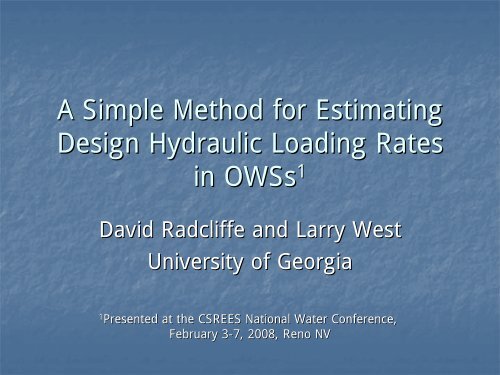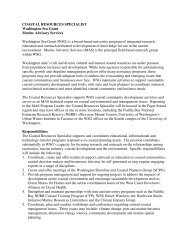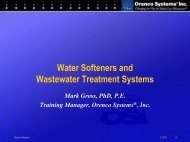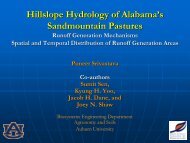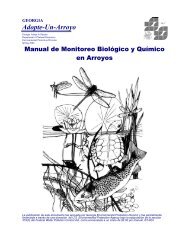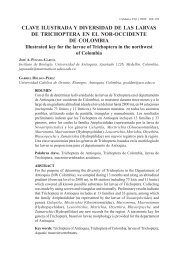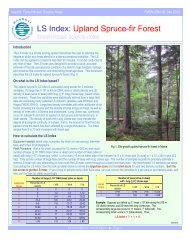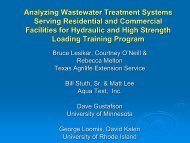A simple method for estimating design hydraulic loading rates in ...
A simple method for estimating design hydraulic loading rates in ...
A simple method for estimating design hydraulic loading rates in ...
Create successful ePaper yourself
Turn your PDF publications into a flip-book with our unique Google optimized e-Paper software.
A Simple Method <strong>for</strong> Estimat<strong>in</strong>gDesign Hydraulic Load<strong>in</strong>g Rates<strong>in</strong> OWSs 1David Radcliffe and Larry WestUniversity of Georgia1Presented at the CSREES National Water Conference,February 3-7, 32008, Reno NV
Onsite Wastewater Systems75% of new homes <strong>in</strong> Georgia are on OWSs
Absorption Field Trench
Design Hydraulic Load<strong>in</strong>g Rate• Wastewater <strong>in</strong>filtration <strong>rates</strong> decl<strong>in</strong>e over timedue to <strong>for</strong>mation of a biomat• Estimate of f<strong>in</strong>al <strong>in</strong>filtration rate needed todeterm<strong>in</strong>e <strong>design</strong> <strong>hydraulic</strong> <strong>load<strong>in</strong>g</strong> rate (HLR D )• Trench l<strong>in</strong>e length based on estimate of HLR D• Also referred to as Long Term Acceptance Rate(LTAR)• LTAR <strong>in</strong>cludes effect of organic <strong>load<strong>in</strong>g</strong> rate• Do not consider organic <strong>load<strong>in</strong>g</strong> rate <strong>in</strong> this analysis
Design Hydraulic Load<strong>in</strong>g Rate• Siegrist (2007)• HLR D varies widely among states & often based onempirical evidence• Need more rational and uni<strong>for</strong>m approach to estimateHLR D• HLR D should be based on trench bottom flux undershallow pond<strong>in</strong>g conditions (normal <strong>load<strong>in</strong>g</strong>)• Reserve trench volume and sidewall flux <strong>for</strong> peak flow (peak<strong>load<strong>in</strong>g</strong>)• Use computer models to aide <strong>design</strong>
Bouma Equation• Bouma (1975) developed <strong>simple</strong> equation <strong>for</strong><strong>estimat<strong>in</strong>g</strong> trench bottom fluxK h h Z0−s+bsZb= Kh ( )• K bs = biomat saturated <strong>hydraulic</strong> conductivity• Z b = biomat thickness• h 0 = height of pond<strong>in</strong>g <strong>in</strong> trench• h s = soil matric potential below biomat• K(h s ) = soil unsaturated <strong>hydraulic</strong> conductivity belowbiomatbs
Bouma EquationKh ( s)Hydraulic Conductivity or Biomat Flux (cm/d)1 . 1001010.10.010 20 40 60 80 10010 3 Absolute Value of Matric Potential Head (cm)?
Hydraulic Conductivity or Biomat Flux (cm/d)Bouma EquationK h h Z sbsZ0 − + ?1 . b1001010.10.010 20 40 60 80 10010 3 Absolute Value of Matric Potential Head (cm)b
Bouma EquationHydraulic Conductivity or Biomat Flux (cm/d)K h − h + Z0 s bbs= Kh (s)Z1 . b1001010.10.010 20 40 60 80 10010 3 Absolute Value of Matric Potential Head (cm)
Bouma EquationHydraulic Conductivity or Biomat Flux (cm/d)K h − h + Z0 s bbs= Kh (s)Z1 . b1001010.10.010 20 40 60 80 10010 3 Absolute Value of Matric Potential Head (cm)
Objectives• Develop <strong>simple</strong> <strong>method</strong> <strong>for</strong> <strong>estimat<strong>in</strong>g</strong> HLR Dbased on soil and biomat <strong>hydraulic</strong> properties• Use Bouma equation to estimate trench bottom fluxunder shallow pond<strong>in</strong>g <strong>for</strong> 12 soil textural classes• Compare Bouma equation estimates to 2D computermodel (HYDRUS)• Take ½ flux as estimate of HLR D (safety factor of 2)• Compare estimates of HLR D to classification systemsthat have been proposed
Soil textural class K s n α θ r θ scm d -1cm -1cm 3 cm -3Sand 642.98 3.18 0.0353 0.053 0.375Loamy sand 105.12 1.75 0.0347 0.049 0.390Silt 43.74 1.68 0.0066 0.050 0.489Sandy loam 38.25 1.45 0.0267 0.039 0.387Silt loam 18.26 1.66 0.0051 0.065 0.439Clay 14.75 1.25 0.0150 0.098 0.459Sandy clay loam 13.19 1.33 0.0211 0.063 0.384Loam 12.04 1.47 0.0111 0.061 0.399Sandy clay 11.35 1.21 0.0334 0.117 0.385Silty clay loam 11.11 1.52 0.0084 0.090 0.482Silty clay 9.61 1.32 0.0162 0.111 0.481Clay loam 8.18 1.41 0.0158 0.079 0.442From Rosetta Lite database <strong>in</strong> HYDRUS
Biomat Properties• F<strong>in</strong>ch et al (2007)• Measurements from 6 OWS sites <strong>in</strong> Georgia• Biomat average thickness ( (Z b ) = 0.5 cm• Biomat average saturated <strong>hydraulic</strong>conductivity ( (K bs ) = 0.23 cm/day• We assumed a loam texture <strong>for</strong> biomat <strong>in</strong>all simulations
0.055 0.086 0.117 0.149 0.180 0.211 0.243 0.274 0.305 0.337 0.368 0.399Water Content - th[-], M<strong>in</strong>=0.055, Max=0.399
Deep water table201816Bouma bottom flux (cm/d)14121086y = 2.032x - 4.1472R 2 = 0.82234200 2 4 6 8 10 12 14 16 18 20HYDRUS bottom flux (cm/d)
Modified Bouma Equation• Orig<strong>in</strong>al equation• Modified equationk∑i=0⎡K h h s−b ⎢ 2⎣ Zb0ZbZ⋅k⎛⎜⎝K h − h + Z0 s bbs= Kh (s)Zb+ 12Zb⎞⋅ i⎟ +k + 1 ⎠bh0⎤⎥⎦h − h + Z0Zsbb=Kh ( )s
Deep water table2018Modified Bouma bottom flux (cm/d)16141210864y = 1.089x - 0.2718R 2 = 0.9583200 2 4 6 8 10 12 14 16 18 20HYDRUS bottom flux (cm/d)
Soil textural classModified Bouma EquationBottom flux Bottom flux / K scm d -1 %Sand 10.31 2Loamy sand 8.88 8Silt 10.80 25Sandy loam 6.62 17Silt loam 9.41 52Clay 4.04 27Sandy clay loam 4.16 32Loam 5.59 46Sandy clay 2.97 26Silty clay loam 5.93 53Silty clay 3.82 40Clay loam 4.00 49
Hydraulic Conductivity or Biomat Flux (cm/d)100101 . 10 3 Pressure Head (cm)Loamy sandSandSilt loamModified Bouma biomat fluxSiltSandy clay10 10 20 30 40 50 60 70 80
Soil textural classcm/dayHLR Dgpd/ft 2ClassSilt 5.40 1.32 ISand 5.16 1.26 ISilt loam 4.71 1.15 ILoamy sand 4.44 1.09 ISandy loam 3.31 0.81 IISilty clay loam 2.97 0.73 IILoam 2.79 0.68 IISandy clay loam 2.08 0.51 IIIClay loam 2.00 0.49 IIIClay 2.02 0.49 IIISilty clay 1.91 0.47 IIISandy clay 1.48 0.36 IV
Conclusions• Modified Bouma equation can be used to develop HLR D<strong>for</strong> OWSs• Based entirely on soil and biomat <strong>hydraulic</strong> properties• Not recommend<strong>in</strong>g a particular set of HLR D but rather aprocess• Users can make many choices to tailor system to their needs• Pond<strong>in</strong>g depth, biomat thickness, biomat conductivity, safetyfactor, soil group<strong>in</strong>gs, etc.• Unsaturated soil and biomat properties are important• Bouma Calculator spreadsheet available at• www. cropsoil.uga.edu/soilphysics/publications.html


